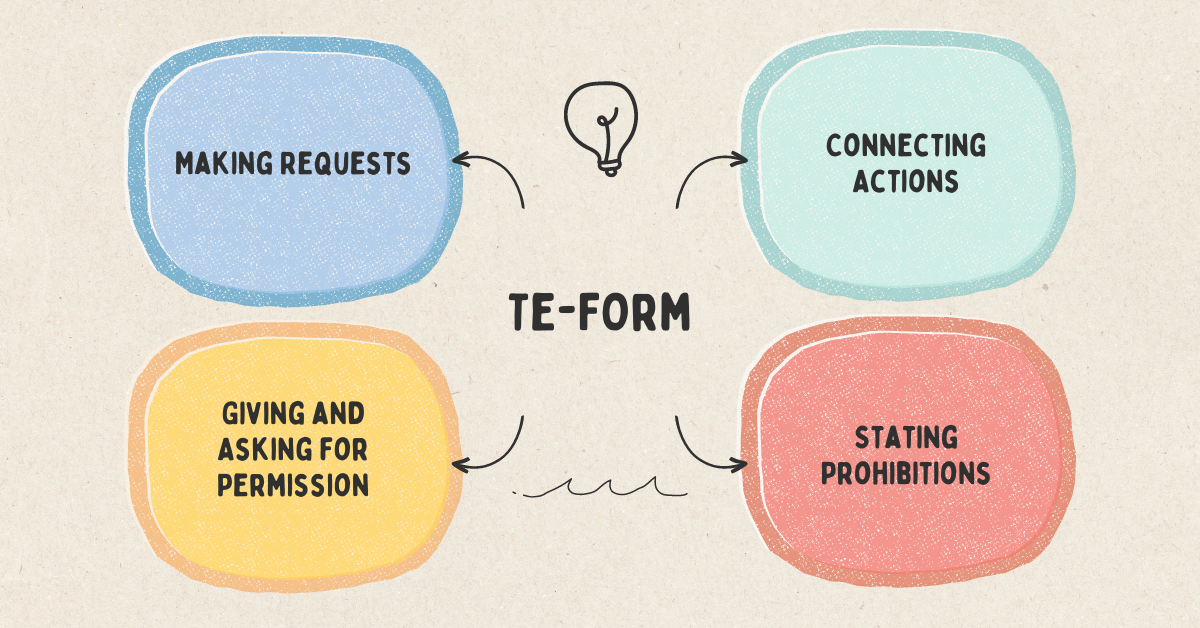
Introduction
Te-forms (て形, te-kei) are a very important part of Japanese grammar. In this post, we will learn how to use them in various situations.
What It Means
The te-form is a verb form used in several grammatical contexts in Japanese. It’s crucial for making requests, connecting actions, giving and asking for permission, and stating prohibitions.
When You Use It
- Making Requests: “…, please.”
- Connecting Actions: “I did this and did that.”
- Giving and Asking for Permission: “You may…/May I…?”
- Stating Prohibitions: “You must not…”
Conjugation Rules
The conjugation of te-forms depends on the type of verb: ru-verbs, u-verbs, and irregular verbs.
Ru-verbs (る動詞, ru-doushi)
- Drop the る (ru) and add て (te).
- Example: 食べる (taberu) → 食べて (tabete)
U-verbs (う動詞, u-doushi)
- The rules for u-verbs are more complex and divided into sub-rules based on the ending of the verb.
- Verbs ending in う (u), つ (tsu), る (ru)
- Change to って (tte)
- Example: 会う (au) → 会って (atte), 待つ (matsu) → 待って (matte), とる (toru) → とって (totte)
- Verbs ending in む (mu), ぶ (bu), ぬ (nu)
- Change to んで (nde)
- Example: 読む (yomu) → 読んで (yonde), 遊ぶ (asobu) → 遊んで (asonde), 死ぬ (shinu) → 死んで (shinde)
- Verbs ending in く (ku)
- Change to いて (ite)
- Exception: 行く (iku) → 行って (itte)
- Example: 書く (kaku) → 書いて (kaite)
- Verbs ending in ぐ (gu)
- Change to いで (ide)
- Example: 泳ぐ (oyogu) → 泳いで (oyoide)
- Verbs ending in す (su)
- Change to して (shite)
- Example: 話す (hanasu) → 話して (hanashite)
Irregular Verbs (不規則動詞, fukisoku doushi)
- する (suru) → して (shite)
- くる (kuru) → きて (kite)
Examples
- Making Requests:
- Please eat. 食べてください (tabete kudasai)
- Please wait. 待ってください (matte kudasai)
- Connecting Actions:
- I met a friend and talked. 友達に会って、話しました (tomodachi ni atte, hanashimashita)
- Giving and Asking for Permission:
- You may read. 読んでもいいです (yondemo ii desu)
- May I write? 書いてもいいですか (kaitemo ii desu ka)
- Stating Prohibitions:
- You must not go. 行ってはいけません (itte wa ikemasen)
Note
Be careful with u-verbs as their te-forms and the stem forms (before ます, masu) are different. For example:
- 会う (au) → 会って (atte), 会います (aimasu)
- 読む (yomu) → 読んで (yonde), 読みます (yomimasu)
Avoid improper forms like: 会いて (compare 会います) and 読みて (compare 読みます).
You may want to memorize each verb as a set, as in 書く-書きます-書いて. Refer to the verb conjugation table below.
| Verb types | Dicitonary forms | Long forms (masu) | te-forms | short past | short present neg. | short past neg. |
| Irr. | する | します | して | した | しない | しなかった |
| Irr. | くる | きます | きて | きた | こない | こなかった |
| ru | たべる | たべます | たべて | たべた | たべない | たべなかった |
| u | かう | かいます | かって | かった | かわない | かわなかった |
| u | まつ | まちます | まって | まった | またない | またなかった |
| u | とる | とります | とって | とった | とらない | とらなかった |
| u | ある | あります | あって | あった | ない* | なかった* |
| u | よむ | よみます | よんで | よんだ | よまない | よまなかった |
| u | あそぶ | あそびます | あそんで | あそんだ | あそばない | あそばなかった |
| u | しぬ | しにます | しんで | しんだ | しなない | しななかった |
| u | かく | かきます | かいて | かいた | かかない | かかなかった |
| u | いく | いきます | いって | いった | いかない | いかなかった |
| u | いそぐ | いそぎます | いそいで | いそいだ | いそがない | いそがなかった |
| u | はなす | はなします | はなして | はなした | はなさない | はなさなかった |
Conclusion
Mastering te-forms is essential for effective communication in Japanese. By practicing these rules and examples, you will improve your understanding and usage of te-forms.



